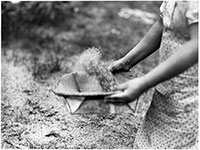Migration Tradition
Oral traditions tell of an Ojibwe migration that began at the Atlantic Seaboard and proceeded westward through the Great Lakes region. At the gathering place called Bahweting, present-day Sault Ste. Marie, the migration wave split into two groups – one went to the north of Lake Superior into Canada and the other group went around the south side of the lake into what is now Michigan and Wisconsin. The westward movement of the Ojibwe was motivated in part by the fur trade with the French. When the beaver population declined in the La Pointe region of northern Wisconsin, it is said that Ojibwe bands radiated “inland, westward and southward towards the beautiful lakes and streams which form the tributaries of the Wisconsin, Chippewa, and St. Croix rivers, and along the south coast of the Great Lake to its utmost extremity, and from thence even inland unto the headwaters of the Mississippi.”(Warren 1885:126). At the end of this migration, the people found the prophesied manoomin, the “food that grows on water” (wild rice).
It is not known how long this migration took place, because oral traditions use terms such as “many strings of lives ago” to denote the passage of time. Into the 1600s, the region of Duluth was still home to Dakota people. French explorers, like Father Claude Jean Allouez, who traveled to the west end of Lake Superior in 1665, were met by the inhabitants of a Dakota village near the mouth of the St. Louis River. Around the great lake lived both Dakota and Ojbiwe as well as Assiniboine and Cree. For this reason, when he sought to encourage peaceful trade in the region Daniel Greysolon, Sieur du Luht, invited leaders from all four of these nations to gather at a meeting held at the west end of Lake Superior on September 15, 1679. Over time, the Ojibwe migration gradually pushed westward and the Dakota shifted their way of life from the woodlands of northern Minnesota to the prairies and plains to the south and west. By the mid-1700s, Ojibwe people had begun to occupy the Duluth area and where Father Allouez had seen a Dakota village, one hundred years later in July of 1767 it was the occupants of a an Ojibwe summer near the mouth of St. Louis River that witnessed the arrival of British explorer Jonathan Carver.
Associated Images
click for larger image with caption
Copyright © 2022. All rights reserved.



